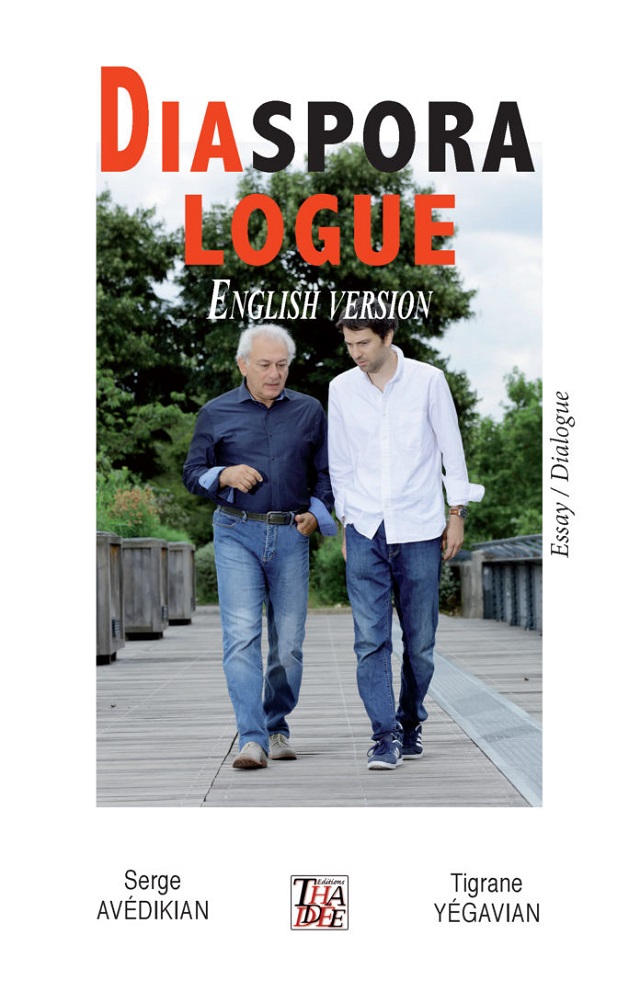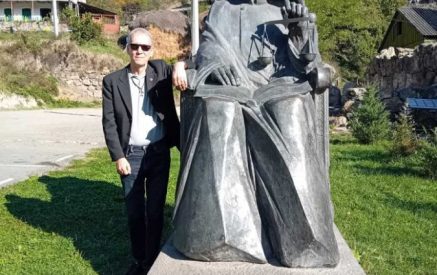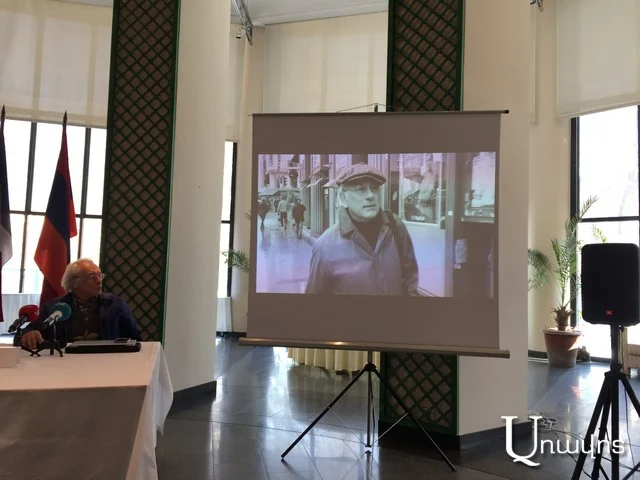The Armenian Mirror-Spectator. History often comes down to us in the form of memorized acts and dates or else completely fictionalized as literary discourse. So it’s a pleasant change to read a series of biographical dialogues between two incisive and successful members of the Armenian diaspora. Serge Avédikian and Tigrane Yegavian have both made their mark in French and French-Armenian circles, the first as a filmmaker and actor (Paradjanov, We Drank from the Same Water), the latter as a journalist and author of several books. (In the Shadow of a Sacred Mountain, Mission). In many ways their work is notable not only for its objective content but also for its ability to have mixed the French and the Armenian contexts and cultures with their own biographical journeys.
Much of what Avédikian and Yegavian discuss in the present volume is in a sense old hat — double allegiances, double cultures, double (sometimes triple) languages—but the personal stories that they interject here render these themes interesting again and gives them new blood. We learn for example that Yegavian’s father ran the Maison de Étudiants Français in the Cité Universtaire in Paris and moved to Lisbon to work for the Gulbenkian Foundation after a bomb exploded in his father’s office, a reaction it seems to recent ASALA bombings and the fact that the Cité housed a number of known ASALA members. Avédikian was born in Soviet Armenia to parents who had repatriated from France during the great reverse migration of 1946-47 known as the nerkaght or return before the family later returned to France.
To me the best parts of this book recount specifically biographical details, as when Avédikian recalls his life in as a child in Armenia: “Yes, I was the son of a repatriated foreigner; that is to say, they called me “François” to mark this fact, or sometimes, in a more vulgar way, akhpari d’gha ‘son of a brother’ (the word ‘brother’ was said with the accent of Armenians coming from outside, from diaspora, to mark the difference). We lived in a semi-basement of a building and the passersby saw what was going on in our apartment. My mother and her girlfriends smoked while drinking coffee, a tradition that is more occidental than oriental.” (p30)
Fascinating as well is the role that books and culture played for both: the Comte de Monte Cristo which Avédikian’s dad read to him as a child stands out, while in Yegavian’s case his formative years at the Lycée Français de Lisbonne provided a continuation of his own French identity and culture. Diasporalogues opens with a well-known quote from Nogoghos Sarafian about being thrown out into the sea of world affairs as an Armenian and learning to survive: and many of the scenes that Avédikian describes about his father’s existence in Marseille and the factories that Armenians worked in will echo in a welcome way scenes from Sarafian’s Bois de Vincennes, for example.
Read also
The book is divided into four parts in which Yegavian and Avédikian broach Armenian and Soviet history; Ottoman and Soviet legacies, as well as the meaning and ways of existing in diaspora at the turn of the 21st century. As in some other parts of the book, Part One (“The France of Our Dreams, The Countries of Our Childhood”) displays a tendency to ramble and to pat oneself on the back.
Part Two “Our Unreal Armenians” is an intellectual dialogue on Armenian identity that will appeal to those vested in issues of identity and dual belongings. The most interesting and rich of the four parts, “Part 3: Language and Transmission” discusses cultural transmission in general; the fourth and last part on Turkish-Armenian relations seems the most incomplete.
At one point Yegavian declares something that Armenians everywhere will recognize and which may summarize one of the main arguments of the book, i.e. that in different ways Armenians have been unable to integrate their culture into the mainstream, in the way that perhaps Jews have done in the American and European contexts. For example: “I don’t want to make comparisons with other diasporas, but the fact of not mastering the linguistic tool, the fact of not being sufficiently integrated in the spheres, the Armenian and the French spheres, is at the root of the situation in which we are today. To me, the mistake was in having wanted to make us believe that this language couldn’t be anything but ‘maternal’. A regrettable error for which to this day we pay the price.” (p114)
English translation issues pervade the text, as in the following passage which mixes up verb tenses and vocabulary, but overall it is an easy enough if sometimes grating read: “We spoke French, which is my mother tongue, while cultivating my Armenian origins. Being named Tigrane (probably the only one in Portugal) is more than a matter of an identity card… Portuguese is the third identity that is imposed, a language exclusively spoken in the preschool.” Also many of the arguments presented are tendentious, but presented as a dialogue or Q & A, they become more opinion than factual assertion.
For all that, Diasporalogues will be of interest mainly to Francophones and Franco-Armenians and to students of diasporan studies. Its specificity is both its strength and its weakness. As mentioned above, the third section “Language and Transmission” is perhaps the strongest, as it addresses issues that affect Armenians worldwide — namely how to transmit a living culture and language long after the last member of the School of Paris, for example — the last great movement of writers who composed in Western Armenia in the Diaspora — Sarafian himself, passed away in 1972.
Overall Diasporalogues is a unique work, an intergenerational as well as inter-artistic text: one generation dialoging with another, journalist and filmmaker, trying to make sense — and ultimately succeeding — in a history (and biographies) uncharacteristically rich in many ways. It’s been almost fifty years now since Sarafian’s death and yet many of the questions that existed then about Armenian identity persist today…At the end of the text, the authors exhort Armenian Americans and Armenians living in other linguistic contexts to take up their challenge and create their own versions of the present text, new Diasporalogues. Let’s hope that that this is just a beginning and that other, equally rich dialogues will emerge in the coming years.
(Translated by Karen Jallatyan with editorial assistance by Alec Ekmekji; Marseille: Editions Thaddée, 207 pp.)
Reviewed by Christopher Atamian
Special to the Mirror-Spectator



























































